Flip test for sciatica
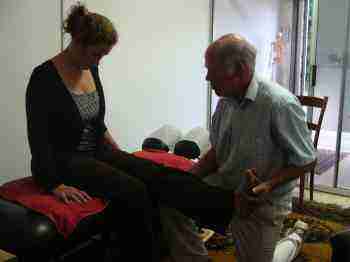
The Flip test for sciatica effectively puts the nerve under increasing tension to examine for possible entrapment.
Maitland's lumbar examination aims to place increasing dural tension on the sciatic nerve to measure possible entrapment in or around the intervertebral foramen.
The standard sciatic nerve stretch test for lower back and leg pain was originally credited to Charles Lasègue more than 150 years ago. Applied together with the Braggard manoeuvre it has been the gold standard for more than a century.
Neither are particularly effective in testing for a mid to upper lumbar lesion affecting the femoral nerve.
Slump is to my mind not necessarily better, but just different, and easier to apply. Simply sit the patient down, and extend the lower leg at the knee. Having to lay the acute patient down for a Lasègue takes longer and is more trying for the patient. It adds further dimensions of dural stretch to the original straight leg raise test.
It also gives a very useful before and after assessment of how
effective the treatment has been. After an effective chiropractic
adjustment, slump test will often be negative, or much less positive.
The two tests together, along with Braggards, complement each
other and sometimes produce baffling contradictions for the clinician.
Lower back and leg pain
Lower back and leg pain is an every day affair at every chiropractic
clinic; less than fifty percent probably have radiating pain initially,
but the patient sits on the edge of a precipice; one false move, or a
sneeze and he or she will have lower back and leg pain.
I have just had a patient with the typical signs of small low lumbar LEFT POSTERO-MEDIAL herniation, fortunately with no leg pain.
As expected, Slump 2 Right provoked Left LBP. And Slump 2 LEFT was negative, provoking neither right nor left pain. (or, sometimes less same-side pain)
But bizarre, SLR right was negative, and SLR left was positive!
In any case, he'll get better, despite not quite understanding the biomechanics. I love PM discs. They get better much quicker.
Flip test for sciatica = Basic Slump
The slump test for sciatica is probably the most commonly used orthopaedic test in my clinic.
Flip 1: Slump the lumbar spine.
The patient with low back and/or leg pain sits in an ordinary upright chair, or on an examination table, it makes no difference. S/he then adopts the slightly slumped (kyphotic) lumbar spine posture, without flexing the whole body forwards. Does it hurt? Where?
In practice, I personally move immediately to Slump 2, finding
that Slump 1 yields little useful information in the management of
lower back and leg pain ...
Flip 2: extend the knee.
The clinician then extends the patient's knee, first of the non-painful leg, to establish a normal muscle stretch, and then followed by extension of the knee of the painful leg.
Aside: I have not seen research comparing active and passive extension of the knee. Both seem to produce much the same result, perhaps with subtle differences that a good research study could elucidate.
In an acute sciatica, Slump 2 will almost always produce an immediate reaction.
Questions: Does it hurt?
1. When I raise your non-painful leg? Where? In the low back? Right, left, centre, both sides? In the non-painful leg? Ominously, does it hurt in the opposite leg (the leg with the suspected nerve-type pain)?
2. Now, when I straight your naughty leg, where does it hurt? In your back, both sides? right? left?, in your leg? where in your leg, tingling in the toes?
Which toes?
Slump 'ouch' sign
The Slump ouch sign is also known as the crossed finding of Fajerstahn
When passive extension of the patient's 'good' leg, the "Well leg raise", reproduces the pain in the painful leg, in my experience, the clinician is always faced with a conundrum. What I call the 'Ouch sign' is not frequently positive, but when it is ...! Usually it is only in the opposite buttock or thigh that pain is experienced, but very occasionally in the lower leg too. Aka the "Crossed sciatic sign."
The challenge of whether to use
- traction only,
- block the pelvis,
- activator,
- Thompson-drops,
- side-posture adjustment of the sacro-iliac joint or the sacrum,
- which vertebra (lumbar roll? hook maoeuvre? spinous-push? and
- lying on which side (painful side up or down?)
gives the thinking Chiropractor a plethora of clinical options making for a very challenging and complex situation.
Aside: An interesting study would be to evaluate how many patients in the Chiropractic clinic with an Ouch sign end up within one year in surgery. I suspect it's quite high. I always take the Ouch sign very seriously, and ensure the patient does too.
ADVANCED Slump test
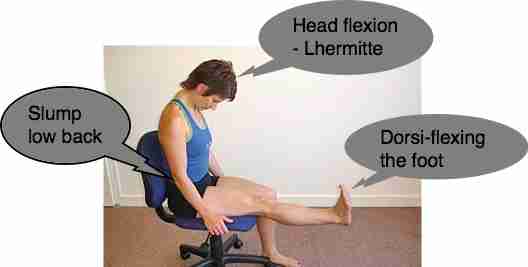
Slump 3: add ankle dorsi-flexion
Progressive stretch is now added to the sciatic nerve, always comparing first the non-painful leg with the painful leg, to distinguish between a tight hamstring, piriformis, calf muscle on the one hand, and true sciatica on the other.
In Slump 3, the ankle is dorsi-flexed. (equivalent to Braggards)
In my notes, I might write, for example:
Slump 3 + right. (R LBP and R posterior thigh stretch/tingle/pain ..)
or:
1. Slump 3 + right (L posterior thigh pain), and
2. Slump 3 +++ left (Left LBP, buttock and posterior thigh pain)
Slump 4: add medial hip rotation.
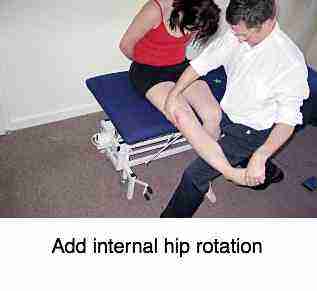
With the lumbar spine slumped, the knee extended, the ankle dorsiflexed, the clinician now medially rotates the whole lower limb, using the ankle (rather than the foot as shown above in the graphic) as a lever.
If Slump 3 was negative, but medial rotation reproduces the pain in the leg, then the patient has a Slump 4 (I always write where the patient experiences the pain. It's extremely useful to come back later and be able to compare.)
Tip. Doing Slump is hard on the Chiropractor's own back. I go down on one knee, and place the patient's leg on my other knee whilst adding ankle dorsiflexion and hip medial rotation.
Slump 5: add head and neck flexion
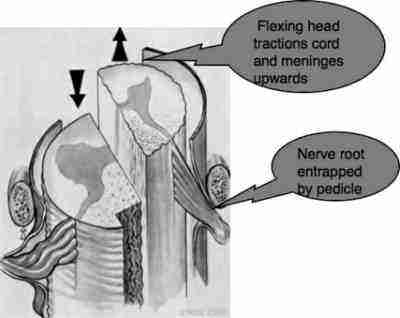
In a typical Lhermitte type manoeuvre, flexing the head and neck slowly adds further stretch to the dura, even drawing the whole cord cephalad, and tractioning the lumbar nerve root up against the pedicle.
In my notes, Slump 5 R+ with right lateral ankle pain would mean that Slump 4 was negative, but flexing the head caused pain, not in the neck but in the low back or leg; it's useful to specify for future reference in order to track the patient's progress.
What impresses both the patient and doctor is when a
positive test, after treatment becomes negative; you both know something
has been achieved.
Here's an interesting thought. Has anyone tried doing a straight leg raise on a patient with an acute brachial neuralgia, to pull the cord in a caudad direction?
Slump 6: add Valsalva
Sometimes Slump 5 may be negative, but adding a Valsalva manoeuvre may elicit the pain.
I always test Valsalva and Lhermitte before starting on the advanced Slump test, so the patient already knows how to do these manoevres.
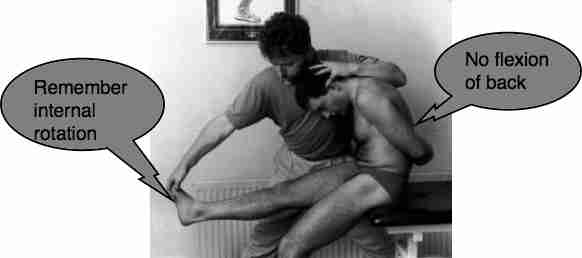
A Slump 7 done vigorously like this could only be done on a completely normal person. Do it gently.
Slump 7: add Cough
Adding a cough SHOULD BE EXTREMELY GENTLY DONE. With the sciatic nerve now under extreme stretch, any vigorous cough or sneeze could be disastrous, but in the presence of a negative Slump 6, it does occasionally conclusively convince the clinician of the presence of a disc lesion.
Help for sciatica pain
There are any number of chiropractic treatments today for sciatica. Side posture manipulation to reduce the disc is my treatment of choice, but it's not always appropriate and, brutally given can certainly increase the bulging disc.
Various forms of traction, drop piece manipulation, activator and others are certainly on the cards.
Help for sciatica painremains the chiropractor's number one priority; and active rehabilitation is paramount if further episodes are to be avoided.
Did you find this page useful? Then perhaps forward it to a suffering friend. Better still, Tweet or Face Book it.
